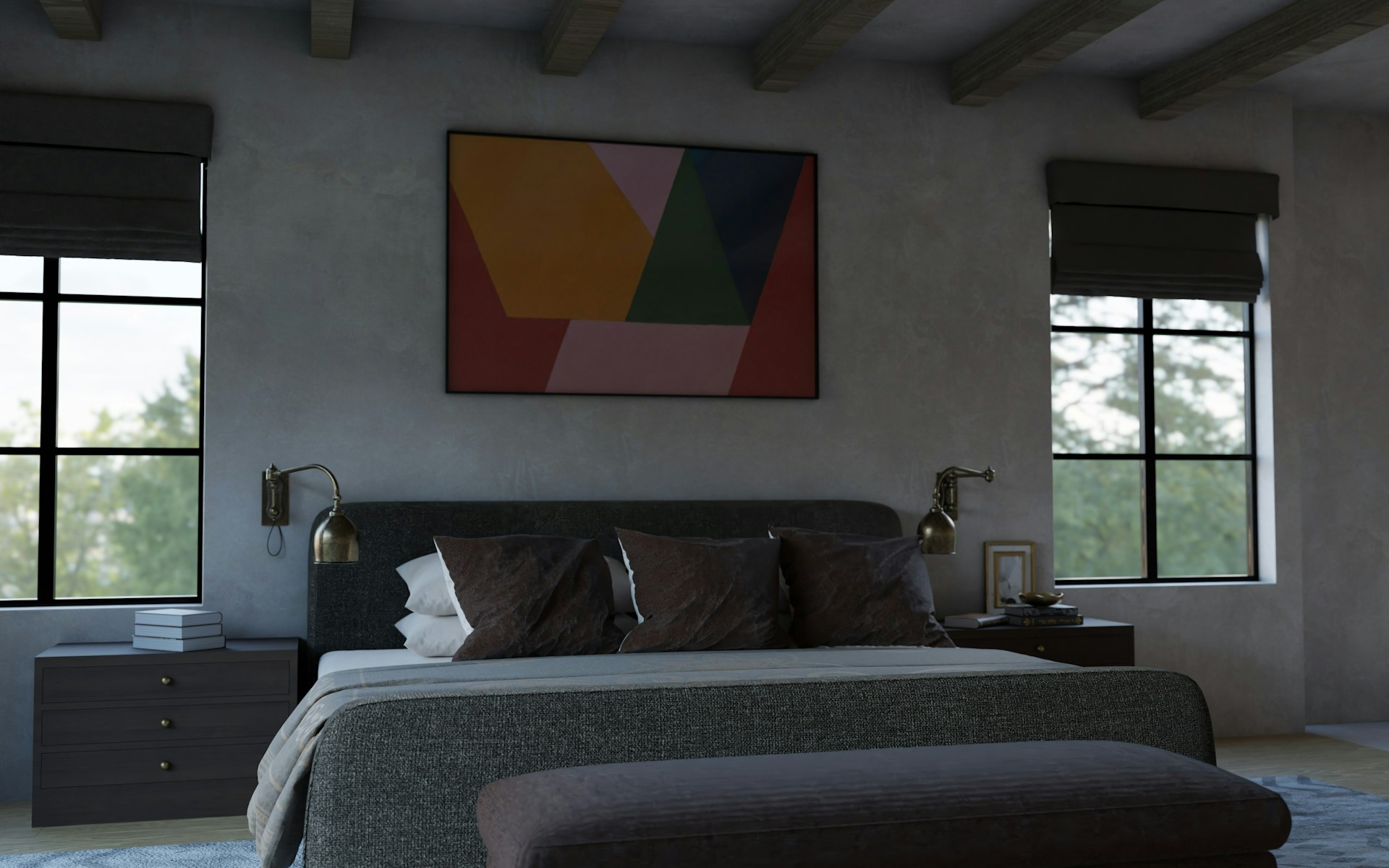Choosing the perfect art for your room can be a delightful, yet daunting task. Art has a magical way of transforming any space, adding character and warmth to your home. But with so many options available, how do you select pieces that not only look beautiful but also fit seamlessly with your room’s style?
In this guide, we will take you through the key steps to choose art that matches your room’s style, helping you create a beautiful and harmonious space. Let’s dive in!
Understanding Your Room’s Style and Theme
Selecting the right art begins with understanding your room’s style and theme. Knowing whether your space is modern, traditional, rustic, or something else will help you choose artworks that fit seamlessly.
Modern and Contemporary
Modern and contemporary rooms often feature clean lines, neutral colours, and minimalistic furniture. For these styles, abstract or geometric art pieces work well. Look for art with bold shapes, sharp lines, and striking colour contrasts. This can enhance the room’s sleek and uncluttered look.
Traditional
Traditional rooms usually have classic furniture, rich colours, and intricate details. Art depicting landscapes, historical scenes, or classic still life can complement this style. Choose ornate frames to match the elegance of the room. The artwork should convey a sense of timelessness and sophistication.
Rustic and Country
Rustic and country styles emphasise natural materials and a cosy feel. Art featuring nature, animals, or farmhouse scenes fits this theme perfectly. Go for pieces that use earthy tones and textured finishes. Wooden frames or canvases can add to the warmth and homeliness of the room.
Eclectic
If your room is eclectic, it’s a mix of various styles. Here, you have more freedom to experiment. Mix and match different art styles, but keep a common element, like colour or subject matter, to maintain harmony. Be playful with your choices, and let your personality shine through.
Understanding your room’s style and theme is key to selecting art that enhances your space. Whether your interior is modern, traditional, rustic, or eclectic, there’s art that will perfectly match your décor.
Choosing the Right Colours and Textures
Colours and textures are crucial when selecting art. They can make or break the harmony of your room, so it’s important to choose wisely.
Complementary Colours
Start by identifying the main colours in your room. Look at your walls, furniture, and accessories. Choose art with colours that complement these elements. For example, if your room has a lot of blue, artwork with gold or orange can create a beautiful contrast. Complementary colours enhance each other, making the art pop without clashing.
Monochromatic Scheme
If you prefer a more subtle look, go for a monochromatic scheme. Choose art that matches the dominant colour in your room but varies in shades. Different tones of the same colour can add depth and interest without overwhelming the space. It’s a sophisticated way to keep things cohesive.
Textures
Textures add an extra dimension to your décor. Think about the finish of your artwork. A glossy print can add a modern touch, while a textured canvas can bring warmth to a rustic room. Mixed media pieces, which combine different materials, can also add intriguing textures and make the space more dynamic.
Accent Colours
Sometimes, a pop of an unexpected colour can change the feel of a room. If your interior is mostly neutral, consider a bright piece of art to add a focal point. This can draw attention and create a striking visual impact.
Choosing the right colours and textures ensures that the art you select not only matches but also enhances your room’s style. By considering complementary colours, monochromatic schemes, and the right textures, you can create a harmonious and visually appealing space.
How to Decide on Size and Placement of Art
Choosing the right size and placement for your artwork is just as important as the art itself. The size should fit the space without overwhelming it, and the placement can make a big difference in how the art is perceived.
Proportion and Balance
The size of the art should be proportionate to the wall and furniture around it. A small piece on a large wall can look lost, while a large piece on a small wall can feel overwhelming. Aim for balance. For example, above a sofa or bed, the artwork should be about two-thirds to three-quarters the width of the furniture. This creates a harmonious look.
Eye Level
Hang art at eye level for the best viewing experience. This means the centre of the piece should be about 57 to 60 inches from the floor. Consider the seated eye level if the artwork is in a dining room or above a sofa. This ensures the piece is easily seen and appreciated.
Groupings and Arrangements
If you’re hanging multiple pieces, think about the arrangement. Gallery walls, where several smaller pieces are grouped together, can make a big impact. Arrange them in a way that feels balanced and cohesive. Keep consistent spacing between frames, around 2 to 3 inches, to maintain a tidy look.
Focal Points
Place your largest and most striking pieces in areas where they can be the focal point. Above the mantel, the sofa, or on an entryway wall are great spots. Highlighting these areas with art draws attention and adds interest to the room.
Choosing the right size and placement ensures your art fits well and enhances your space. By considering proportion, balance, eye level, and focal points, you create a visually pleasing environment where the art truly shines.
Creating a Cohesive Look with Multiple Art Pieces
Creating a cohesive look with multiple art pieces can transform a room. Whether you have a gallery wall or just a few pieces, harmony is key.
Choose a Common Theme
Start by selecting a common theme. This could be a colour scheme, subject matter, or art style. Having a unifying element ties the pieces together, making the collection feel intentional. For example, choosing pieces with a nature theme or a set colour palette can create a cohesive look.
Mix and Match Frames
Using matching frames can create unity, but don’t be afraid to mix it up. Different frames can add character and interest, especially if you stick to a similar colour or style. For example, mixing wooden frames of different shades can look cohesive in a rustic-themed room.
Consistent Spacing
When hanging multiple pieces, keep consistent spacing between them. Regular spacing, such as 2 to 3 inches between frames, makes the arrangement look neat and balanced. Irregular spacing can look chaotic and unplanned.
Consider Layouts
Think about the layout before you start hanging. Lay the pieces out on the floor first to see how they look together. Experiment with different arrangements until you find one that feels right. Consider the shapes and sizes of the art; mixing different sizes can create a dynamic and interesting display.
Creating a cohesive look with multiple art pieces involves choosing a common theme, mixing and matching frames thoughtfully, keeping consistent spacing, and planning your layout. These steps help ensure your collection looks balanced and attractive, enhancing the beauty of your room.
Conclusion
Choosing art that matches your room’s style involves careful consideration of various factors. From understanding your room’s theme and selecting the right colours and textures, to deciding on the appropriate size and placement, each step is crucial. Creating a cohesive look with multiple art pieces brings another layer of harmony and beauty to your space.
Art has the power to transform a room, adding personality and depth. By following these guidelines, you can select pieces that not only fit your décor but also elevate your home’s overall aesthetic.
Discover a wide range of artworks by modern and contemporary British artists at White Court Art. Explore our collection of British modern art to find pieces that will perfectly complement your room’s style. Visit our website today and let us help you bring your vision to life.

